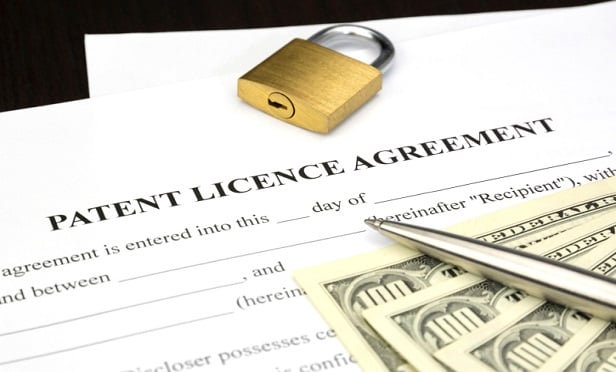Features

Damages for Extraterritorial Infringement of U.S. Patents
A look at the gray area of infringement of U.S. patents in the U.S., but with related consequences or actions outside the U.S.
Columns & Departments
IP News
Penn State Files Trademark Lawsuit against Sports Beer Brewing Company Can OSU Trademark the Word "The"?
Features

Analysis of Warhol Art Fair Use Ruling
The U.S. District Court for the Southern District of New York held that a series of silkscreen paintings and prints by Andy Warhol based on a photograph of music legend Prince taken by Lynn Goldsmith constituted a transformative fair use.
Features

Seeing Green: Protecting Brands In the Cannabis Industry
Branding is not a new concept, nor are the various intellectual property laws that protect brands. What is new to most is how this burgeoning industry can take advantage of those laws within the context of state and federal restrictions.
Features

Rights and Obligations In Patent Licenses
The owner of a commercially successful patent may have competing desires. On one hand, the patent owner wants to protect the patent and secure its maximum benefit; on the other hand, the patent owner wants to avoid enforcement litigation with competitors because it is expensive and puts the patent at risk.
Features

Did Congress Create Unintended Risks to Innovators In the AIA?
Many observers greeted the passage of the AIA into law as a long-overdue overhaul of U.S. patent law that aligned it with patent systems prevailing in the rest of the world. Who knew what mischief just seven of the AIA's more than 25,000 words contained? The U.S. Supreme Court answered earlier this year.
Features

SCOTUS to Address Whether Lanham Act Requires Willful Infringement for Profit Disgorgement
The decision in Romag Fasteners v. Fossil will bring welcome uniformity, ending the status quo where eligibility to recover profits under the Lanham Act depends on which court is deciding the dispute
Features

Limit in Supreme Court Striking Down Ban On 'Scandalous' Trademarks
In the U.S. Supreme Court's ruling in Iancu v. Brunetti, Justice Sonia Sotomayor's dissent cautioned that the decision is likely to pave a path to a "coming rush to register [vulgar, profane, or obscene] trademarks." The reasoning stems from the court's majority finding that a portion of 15 U.S.C. §1052 — which had previously prohibited the registering of "immoral" or "scandalous" trademarks — is unconstitutional. Practically speaking, however, this "coming rush" will likely not be the case, even via the entertainment industry.
Features

Supreme Court Holds Bar Against Registration of Immoral or Scandalous Marks Violates the First Amendment
Iancu v. Brunetti The Supreme Court held the bar against registration of immoral or scandalous marks "collided" with well-established free speech doctrine, namely, that laws disadvantaging speech based on the views expressed thereby violate the First Amendment.
Features

Case on 'Coolcore' Marks Settles a 34 Year Debate Regarding Bankruptcy and IP Law
The U.S. Supreme Court issued its long-awaited decision in <i>Mission Product Holdings, Inc. v. Tempnology </i>, ruling that a trademark licensee can retain its rights under a trademark license agreement that is rejected by the licensor as an executory contract in bankruptcy.
Need Help?
- Prefer an IP authenticated environment? Request a transition or call 800-756-8993.
- Need other assistance? email Customer Service or call 1-877-256-2472.
MOST POPULAR STORIES
- Second Circuit Reinforces Bankruptcy Code Settlement Payment Safe HarborThe Second Circuit affirmed the lower courts' judgment that a "transfer made … in connection with a securities contract … by a qualifying financial institution" was entitled "to the protection of ... §546 (e)'s safe harbor ...."Read More ›
- The DOJ's New Parameters for Evaluating Corporate Compliance ProgramsThe parameters set forth in the DOJ's memorandum have implications not only for the government's evaluation of compliance programs in the context of criminal charging decisions, but also for how defense counsel structure their conference-room advocacy seeking declinations or lesser sanctions in both criminal and civil investigations.Read More ›
- The DOJ's Corporate Enforcement Policy: One Year LaterThe DOJ's Criminal Division issued three declinations since the issuance of the revised CEP a year ago. Review of these cases gives insight into DOJ's implementation of the new policy in practice.Read More ›
- Use of Deferred Prosecution Agreements In White Collar InvestigationsThis article discusses the practical and policy reasons for the use of DPAs and NPAs in white-collar criminal investigations, and considers the NDAA's new reporting provision and its relationship with other efforts to enhance transparency in DOJ decision-making.Read More ›
- Questions Every Law Firm Business Development Leader Should Be AskingIn a legal marketplace transformed by technology, heightened client expectations, and fierce competition, law firm leaders must approach strategy with rigor and clarity. The following questions, accompanied by relevant statistics and explanations, offer a focused guide for uncovering opportunity and driving sustainable growth.Read More ›
